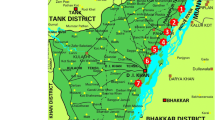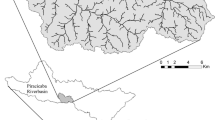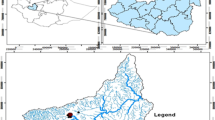Abstract
In this investigation, concentrations of physico-chemical and bacteriological qualities of water samples from the major streams within the Owabi watershed in Kumasi, Ghana, were measured at five different locations. The streams were moderately soft and neutral, having a mean pH range of 7.08 ± 0.2 to 7.88 ± 0.6. Total dissolved solids, total suspended solids, grease and oil, alkalinity, and the major ion levels varied significantly at each sampling site. Nutrient levels were however low and did not show any clear variation at sample locations. The bacteriological quality of the water was poor, rendering it unsafe for domestic purposes without treatment. The poor bacteriological quality was due to direct contamination by animal and human wastes. The streams have an appreciable self-purification capacity which is stressed by persistent pollution overloads caused by expanding human activities within the catchment. Cluster analysis performed on the data to determine pollution patterns between the streams depicts that River Owabi was less polluted, Rivers Akyeampomene and Sukobri were moderately polluted, while River Pumpunase was highly polluted.
Similar content being viewed by others
References
Ansa-Asare, O. D., & Asante, K. A. (1998). A comparative study of the nutrient status of two reservoirs in southeast Ghana. Lakes and Reservoirs, Research and Management, 3, 205–217. doi:10.1046/j.1440-1770.1998.00074.x.
Ansa-Asare, O. D., & Asante, K. A. (2005). The water quality of Birim Stream in South-East of Ghana. West African Journal of Applied Ecology, 8, 23–34.
Akpabli, C. K., & Drah, G. K. (2001). Water quality of the main tributaries of the Densu Stream. Journal of the Ghana Science Association, 3(2), 84–94.
APHA.AWWA, WEF (1998). Standard methods for the examination of water and wastewater (20th ed.). Washington, DC: APHA.
Buchholz, R. A. (1998). Principles of environmental management. The greening of business (2nd ed.). London: Prentice-Hall.
Burton, J. D., & Liss, P. S. (1976). Estuarine chemistry. New York: Academic. 7:229.
Chapman, D. (1996). Water quality assessment. A guide to the used of biota, sediments and water in environmental monitoring (2nd ed.). London: E. and F. N. Spon.
Dallas, H. F., & Day, J. A. (1993). The effect of water quality variables on rivers and ecosystems. Water Research Monitoring Commission report No. TT 61/93. South Africa.
DFID (1999). A Simple Methodology for Water Quality Monitoring. Report OD 142 (KAR Project R6662). In G. R. Pearce, M. R. Chandhry, & S. Ghulum (Eds.), A simple methodology for water quality monitoring (p. 16). HR Wallingford: UK.
Feng, P., Weagant, S. D., & Grant, M. A. (2002). Enumeration of Escherichia coli and the Coliform Bacteria. US FDA/CFSAN.
Fakayode, S. O. (2005). Impact of industrial effluents on water quality of the receiving Alaro River in Ibadan, Nigeria. AJEAM-RAGEE, 10, 1–13.
Karikari, A. Y., & Ansa-Asare, O. D. (2006). Physico-chemical and microbial water quality assessment of Densu Stream of Ghana. West African Journal of Applied Ecology, 10(10), 158.
Karikari, A. Y., & Bosque-Hamilton, E. K. (2004). The water quality of Lake Bosomtwi and its feeder streams. Journal of the Ghana Science Association, 6, 117–127.
Kempster, P. L., Van Vliet, H. R., & Kuhn, A. (1997). The need for guide to bridge the gap between ideal drinking water quality and quality which is practicable, available and acceptable. Water South Africa, 23(20), 163–167.
Langmuir, D. (1997). Aqueous environmental geochemistry. Upper Saddle River: Prentice-Hall.
Lester, J. N., & Birkett, J. W. (1999). Microbiology and chemistry for environmental scientists and engineers (2nd ed.) New York: E and FN Spon. Management, Office of Water Quality, Assessment Branch, Surveys Section, Indianapolis.
MacCutcheon, S. C., Martin, J. L., & Barnwell, T. O., Jr. (1983). Water quality. In Handbook of hydrology. New York: McGraw-Hill.
McGregor, D. F. M., Thompson, D. A., & Simon, D. (2000). Water quality and management in peri-urban Kumasi, Ghana. Case Study 16 inland-water linkages in rural watersheds. Rome: FAO. Electronic workshop.
Mehrdadi, N., Ghobadi, M., Nasrabadi, T., & Hoveidi, H. (2006). Evaluation of the quality and self purification potential of Tajan Stream using QUAL2E Model. Iranian Journal of Environmental Health Science and Engineering, 3(3), 199–204.
Millipore. (1991). Water microbiology. Laboratories and field procedures (p. 32). Bedford: Millipore.
Obiri-Danso, K., Weobong, C. A. A., & Jones, K. (2005). Aspects of health-related microbiology of the Subin, an urban stream in Kumasi, Ghana. Journal of Water and Health, 3, 69–76.
Pestle, S. (1997). Fairing water scarcities. World Watch Environmental Alert Series, 38, 239.
Sharpley, A. N., Smith, S. J., & Naney, J. W. (1987). The environmental impact of agricultural nitrogen and phosphorus use. Journal of Agricultural and Food Chemistry, 35, 812–817. doi:10.1021/jf00077a043.
Statistical Service (2000). Ghana population and housing census, statistical service. Accra: Ghana Publishing.
Stumn, W., & Morgan, J. J. (1981). Aquatic chemistry (p. 780). New York: Willey.
Svobodová, Z., Lloyd, R., Máchová, J., & Vykusová, B. (1993). Water quality and fish health. EIFAC Technical paper No. 54. FAO.
Tay, C. K. (2007). Chemical characteristics of groundwater in the Akatsi and Ketu Districts of the Volta Region, Ghana. West African Journal of Applied Ecology, 11, 3–25.
UNEP (2000). Global Environmental Outlook, United Nations Environment Programme Global State of the Environment Report, 2000.
Verma, B. L., & Srivastava, R. N. (1990). Measurement of the personal cost of illness due to some major water-related issues in an Indian rural population. International Journal of Epidemiology, 19, 169–176. doi:10.1093/ije/19.1.169.
WHO (2003). Background document for preparation of WHO Guidelines for drinking-water quality. Geneva, World Health Organization. WHO/SDE/WSH/03.04
WHO (2004). Guidelines for drinking water quality (Addendum). Geneva. www.who.int/water_sanitation-health/publications/facts2004/en/index.html
Author information
Authors and Affiliations
Corresponding author
Rights and permissions
About this article
Cite this article
Akoto, O., Bruce, T.N. & Darko, G. Chemical and biological characteristics of streams in the Owabi watershed. Environ Monit Assess 161, 413–422 (2010). https://doi.org/10.1007/s10661-009-0757-4
Received:
Accepted:
Published:
Issue Date:
DOI: https://doi.org/10.1007/s10661-009-0757-4




